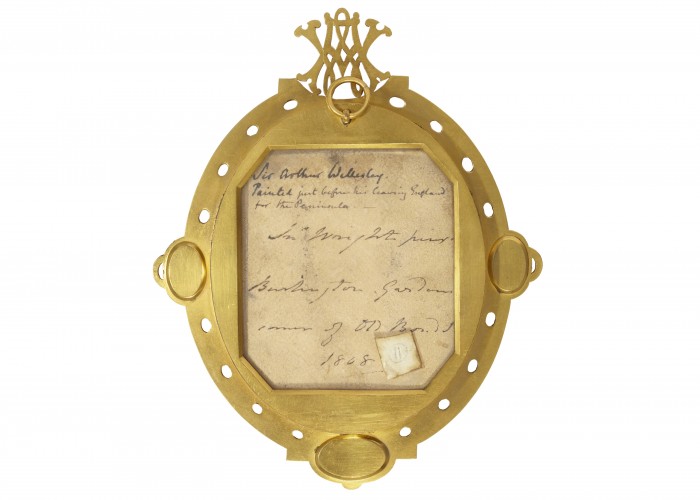Miniature Portrait with Hair from Duke of Wellington
This miniature painted portrait of the Duke of Wellington is adorned with three locks of hair, set into the gold case. Two are from the Duke of Wellington at different stages in his life, and one is from his most famous horse, Copenhagen. Intended to celebrate the life and career of the Duke of Wellington, this miniature shows the growing celebrity status of figures like the Duke after the Battle of Waterloo.
The height of the Duke of Wellington’s illustrious military career was dominated by his defeat of the Emperor Napoleon at Waterloo. This final victory over the French led to a cult of personality around Wellington, making artefacts like this locket popular.
Designed to commemorate the Duke’s life, the miniature incorporates locks of his hair and that of his famous horse Copenhagen. The hair in this miniature exhibits three almost distinct stages of Wellington’s career, enabling the owner of the miniature to feel a connection with the great man.
The lock of hair on the left dates from 1808 when Wellington first embarked upon his campaigns against Napoleon’s armies in the Iberian peninsular. Wellington’s Peninsular campaigns secured him a place in the popular consciousness, with honours bestowed upon him by the British government. At the base of the miniature is a lock of hair taken from Wellington’s horse Copenhagen, the mount he rode throughout the Battle of Waterloo. At this point in Wellington’s life he had become, according to one writer, “a national institution” with his popularity exceeding the heights it had reached during his campaigns in Spain. This cemented the Duke’s intrinsic link with the Napoleonic craze that had been started by the Prince Regent and dominated Regency Britain.
Sadly by the time the third lock of Wellington’s hair was taken after his death in 1852, Wellington’s reputation had declined significantly. It was his political career, which particularly affected his standing. After the war he entered the House of Commons and by 1828 had assumed the position of Prime Minister.
His far-right conservative polices were at odds with the popular movements of liberalism and the growing agitation for political change, symbolised by popular protests across the country. However Wellington stubbornly refused to introduce the Reform Act until 1832, a delay which brought down his administration. His carriage was booed in the streets, and iron shutters had to be installed on the windows of his London house, to prevent stone-throwing protestors from breaking the windows. It was only the support of the young Queen Victoria, who viewed the Duke as a father figure, that went some way to restoring his reputation.
This miniature serves as a reminder of Wellington’s place as both conqueror and national treasure in the hearts of the British nation.
-
Curatorial info
- Originating Museum: Levens Hall
- Production Date: c. 1852
- Material: Gold, hair, oil on ivory
-
Use this image
You can download and use the high resolution image for use in a non-profit environment such as a school or college, but please take note of the license type and rights holder information below
- Rights Holder: Copyright Levens Hall. Photography Relic Imaging Ltd.
- License Type: Creative Commons
Find it here
This object is in the collection of Levens Hall









